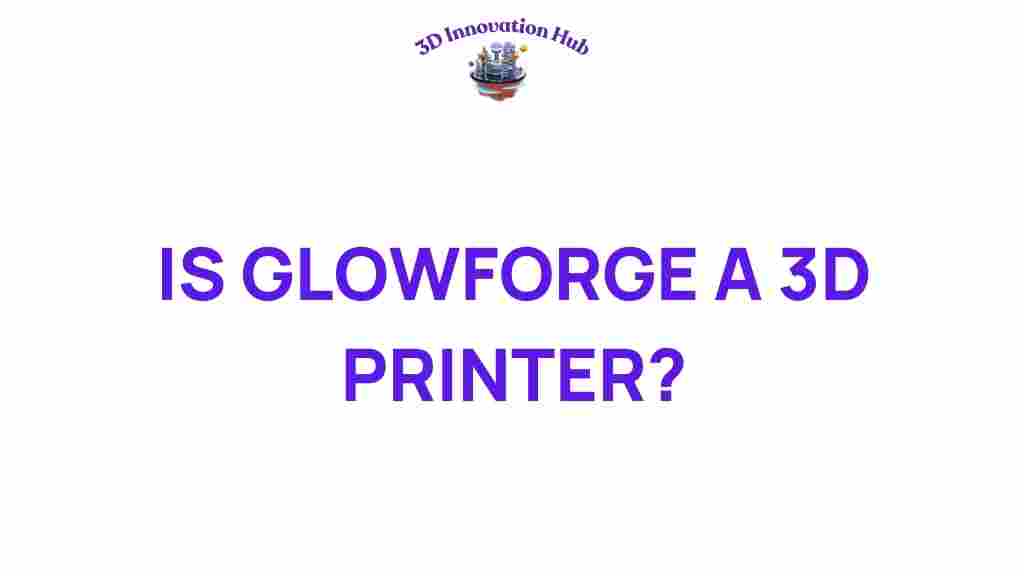Is Glowforge a 3D Printer? Unveiling the Truth Behind the Buzz
In the realm of modern fabrication and DIY innovation, the Glowforge has emerged as a popular tool among makers, designers, and hobbyists alike. However, a common question arises: Is Glowforge a 3D printer? To fully understand this, we must delve into the technology behind Glowforge, its applications, and how it fits into the broader category of fabrication tools.
Understanding Glowforge Technology
The Glowforge is primarily known as a laser cutter and engraver. It uses a high-powered laser to cut through or engrave various materials like wood, acrylic, leather, and more. Unlike traditional 3D printers, which build objects layer by layer from materials like plastic filament, the Glowforge subtractively carves out designs from flat sheets of material.
What is a 3D Printer?
A 3D printer, in contrast, is a machine that creates three-dimensional objects by adding material layer by layer. This process is known as additive manufacturing, and it utilizes materials such as:
- PLA (Polylactic Acid)
- ABS (Acrylonitrile Butadiene Styrene)
- Resins
- Filaments
3D printers are often used for prototyping, creating complex geometries, and producing custom parts, making them a staple in makerspaces around the world.
Glowforge vs. 3D Printers: Key Differences
To clarify the distinctions between Glowforge and traditional 3D printers, let’s explore their fundamental differences:
- Manufacturing Method: Glowforge uses a laser to cut and engrave, while 3D printers add material layer by layer.
- Material Uses: Glowforge works with flat materials, while 3D printers typically use filament or resin.
- Design Capabilities: Glowforge is excellent for intricate surface designs and custom engravings, while 3D printers excel at creating complex 3D shapes.
The Role of Glowforge in Makerspaces
Makerspaces are community-driven workshops that encourage hands-on learning and the sharing of tools and resources. The Glowforge has become a popular addition to many makerspaces due to its versatility and user-friendly design. Here’s how it fits in:
- Educational Tool: Many makerspaces use Glowforge to teach users about design, engineering, and fabrication techniques.
- Community Projects: Collaborative projects can be easily achieved with a Glowforge, allowing multiple users to contribute their ideas and designs.
- Accessibility: The Glowforge is relatively easy to use, making it accessible for beginners while still offering advanced capabilities for experienced users.
How to Use Glowforge: A Step-by-Step Process
Using a Glowforge is an exciting journey into the world of fabrication. Here’s a simple step-by-step guide to getting started:
Step 1: Setup Your Glowforge
Follow these steps to set up your Glowforge:
- Unbox the machine and place it in a well-ventilated area.
- Connect it to a power source and your Wi-Fi network.
- Download the required software from the official Glowforge website.
Step 2: Design Your Project
Creating a design can be done through various software options:
- Glowforge’s App: You can create designs directly in the Glowforge app, which supports SVG, PDF, and other formats.
- Third-Party Software: Use design software like Adobe Illustrator or Inkscape to create complex designs.
Step 3: Prepare Your Material
Select the appropriate material for your project. Ensure that the material fits within the Glowforge’s specifications:
- Wood
- Acrylic
- Leather
- Paper
Step 4: Upload Your Design
Once your design is ready, upload it to the Glowforge app. Adjust the settings according to the type of material and the desired outcome:
- Select whether you want to cut, engrave, or score the material.
- Adjust the speed and power settings based on the thickness and type of material.
Step 5: Start the Engraving or Cutting Process
After you’ve set everything up, it’s time to start the Glowforge. Click on the “Print” button in the app, and watch as the laser cutter brings your design to life.
Step 6: Finishing Touches
Once the process is complete, remove your material and do any necessary finishing work, such as sanding or painting.
Troubleshooting Common Glowforge Issues
Even though the Glowforge is user-friendly, you may encounter occasional issues. Here are some common problems and solutions:
Issue 1: Misalignment of Cuts
If your cuts or engravings are misaligned, check the following:
- Ensure that the material is flat and properly positioned on the bed.
- Check if the artwork is correctly aligned in the Glowforge app.
Issue 2: Inconsistent Engraving
For inconsistent engraving results, consider these tips:
- Adjust the power settings based on the material thickness.
- Make sure your material is clean and free from debris.
Issue 3: Smoke or Odor
While the Glowforge has a built-in filtration system, you may still notice some smoke or odor:
- Ensure that you are using suitable materials that are compatible with the Glowforge.
- Consider using an external ventilation system for enhanced air quality.
Conclusion: The Glowforge and Its Place in Modern Fabrication
To wrap up, the Glowforge is not a 3D printer but a powerful laser cutter and engraver designed for a variety of materials. It plays a significant role in the world of makerspaces, enabling users to explore their creativity and innovate in the realm of design and fabrication. Whether you’re a seasoned maker or a beginner looking to dive into the world of DIY projects, the Glowforge offers an exciting avenue for bringing your ideas to life.
For anyone interested in learning more about the Glowforge and its capabilities, consider visiting the official Glowforge website for detailed resources and community support. Additionally, if you’re looking to explore more about 3D printing technologies, check out this informative article on 3D printing advancements.
Embrace the innovation, and start creating with the Glowforge today!
This article is in the category and created by 3D Innovation Hub Team
